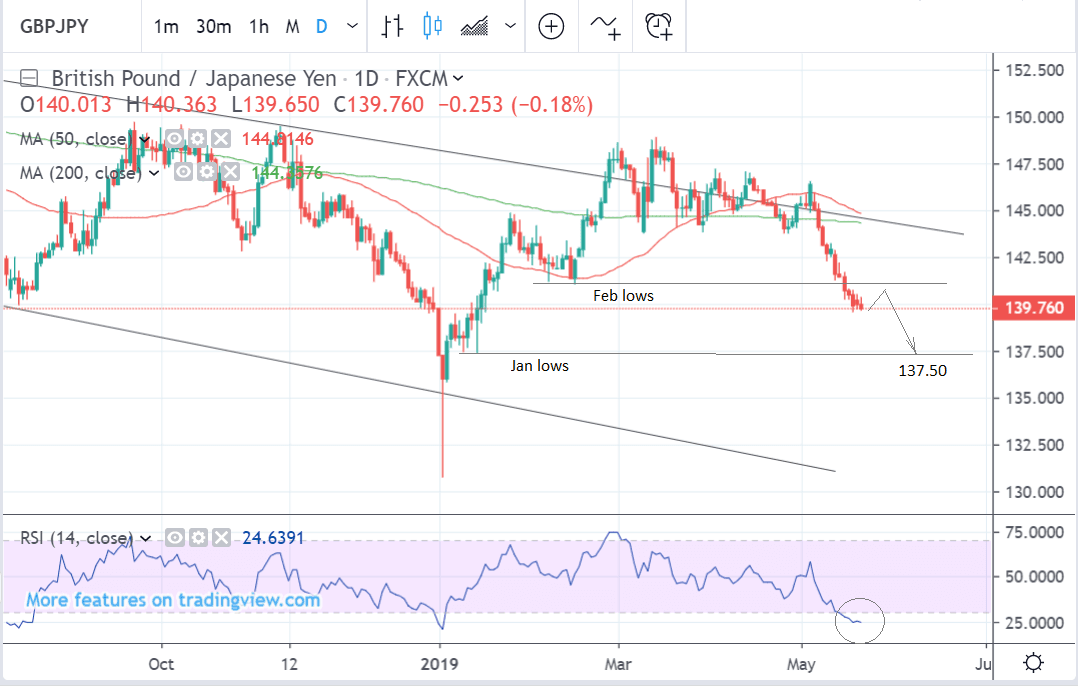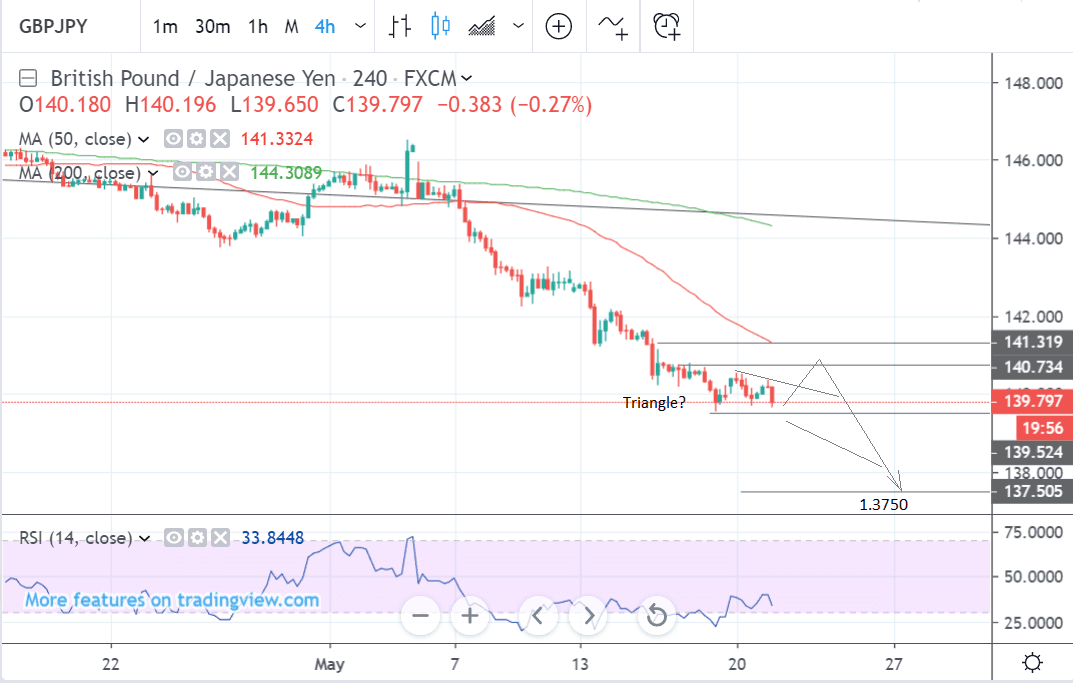Pound / Japanese Yen Outlook: Downtrend to Extend, Short-Term Relief Bounce Possible

Image © Adobe Stock
- GBP/JPY is in concerted downtrend
- Oversold momentum suggests temporary correction
- Yen to take direction from global investor risk trends
The Pound-to- Yen exchange rate is trading at 139.79 at the time of writing, down 0.1% on the week 5.0% down from its April highs.
GBP/JPY is falling like most Sterling pairs and from a technical perspective, it is now in an established downtrend which according to the old adage ‘the trend is your friend’ is more likely to extend than ‘bend’.
Next stop is 137.50 and the January lows since prices tend to gravitate to former levels of support and resistance.
The one fly in the ointment technically is that the pair has fallen to oversold territory according to the RSI indicator in the bottom panel (circled). This cautions against traders opening any further bearish bets. It also indicates an increased chance the pair could pullback from oversold levels, stall, or go sideways.
If GBP/JPY does correct, one place where it might pull back to is the February low at 141.00. A break above the February low would bring into the question the dominance of the downtrend.
The four-hour chart above shows how the pair has already started to go sideways since falling to the May lows. It is possible it may be forming a triangle or pennant continuation pattern. Either of these is likely to result in a break lower to the 137.50 target eventually, once complete.
Also highlighted on the 4hr chart is a band of resistance between 140.70 and 141.30 which could be another ceiling level resisting pullbacks.
Time to move your money? Get 3-5% more currency than your bank would offer by using the services of foreign exchange specialists at RationalFX. A specialist broker can deliver you an exchange rate closer to the real market rate, thereby saving you substantial quantities of currency. Find out more here.
* Advertisement
The Japanese Yen: What to Watch
On the hard data front, CPI is the next major release for the Yen on the economic calendar. Core CPI is forecast to rise to 0.9% in April from 0.8% previously when released at 00.30 BST on Friday, May 24. If it rises more than expected it could push the Yen higher as it may indicate the possibility the Bank of Japan (BOJ) will stop excessive easing measures which have long kept a lid on JPY appreciation.
The Yen found support on recent GDP data out on Monday, which beat expectations, providing a glimmer of hope that the Japanese economy might escape its moribund growth trajectory.
First quarter GDP rose by 0.5% compared to estimates of only -0.1% and higher than the previous quarter’s 0.4%. This translated into a 2.1% annualised rate of growth.
“Behind the positive surprise lie several factors that include 1) business investment decreases less than the market had expected, 2) inventories contributed positively to GDP growth, contrary to expectations, and 3) net exports add slightly more to GDP than expected, because imports plunge 4.6% QoQ,” say Citibank in a note to clients.
From a fundamental perspective, the outlook for the Yen is positive. With trade tensions intensifying and a worsening outlook for global growth the safe-haven credentials of the currency suggest it could continue to find support.
“Our preference remains the yen here, given our concerns that the S&P 500 could turn lower again,” says Chris Turner, Chief FX Strategist at ING, who adds, “faced with: a) an escalating US-China trade war taking on some unedifying nationalist tones, b) oil rising on supply concerns as Iran is backed into a corner in the Middle East and c) a late cycle US economy, investors will be focused more on preserving capital. This dark mood is playing out in the FX space, where any rallies in commodity currencies quickly fizzle.”
The main risk is that the trade war intensifies, and if so this would be positive for the Yen. A key risk would be the U.S. expanding tariffs to include another circa $300bn of Chinese goods.
Last week saw Yen gains as one international trade deal after another fell apart, as well as the U.S. and China introduced higher tariffs on each other’s imports.
News the U.S. had targeted Chinese phone-maker Huawei as a potential source of national security risk and banned U.S. companies from using Huawei technologies was the latest turn in the evolving trade war. Although the Yen was curiously unaffected by the news, fears of a spill-over into global equity markets could see the rise on strong inflows.
Further out there is also the risk that the U.S. will impose tariffs on Japanese autos after a 6-month consultation period. Yet at the same time negotiations between the two countries are ongoing and could result in no tariffs. If they were imposed it would probably be negative for the Yen.
It was reported that U.S. Trade Representative Robert Lighthizer will travel to Japan on May 24. He will meet Japanese Economy Minister Toshimitsu Motegi to resume trade negotiations.
Trump declared auto-imports as threat to national security last week. And Lighthizer will have 180 days to complete the trade agreement or Trump might start imposing tariffs on autos and parts from Japan.
Time to move your money? Get 3-5% more currency than your bank would offer by using the services of foreign exchange specialists at RationalFX. A specialist broker can deliver you an exchange rate closer to the real market rate, thereby saving you substantial quantities of currency. Find out more here.
* Advertisement


